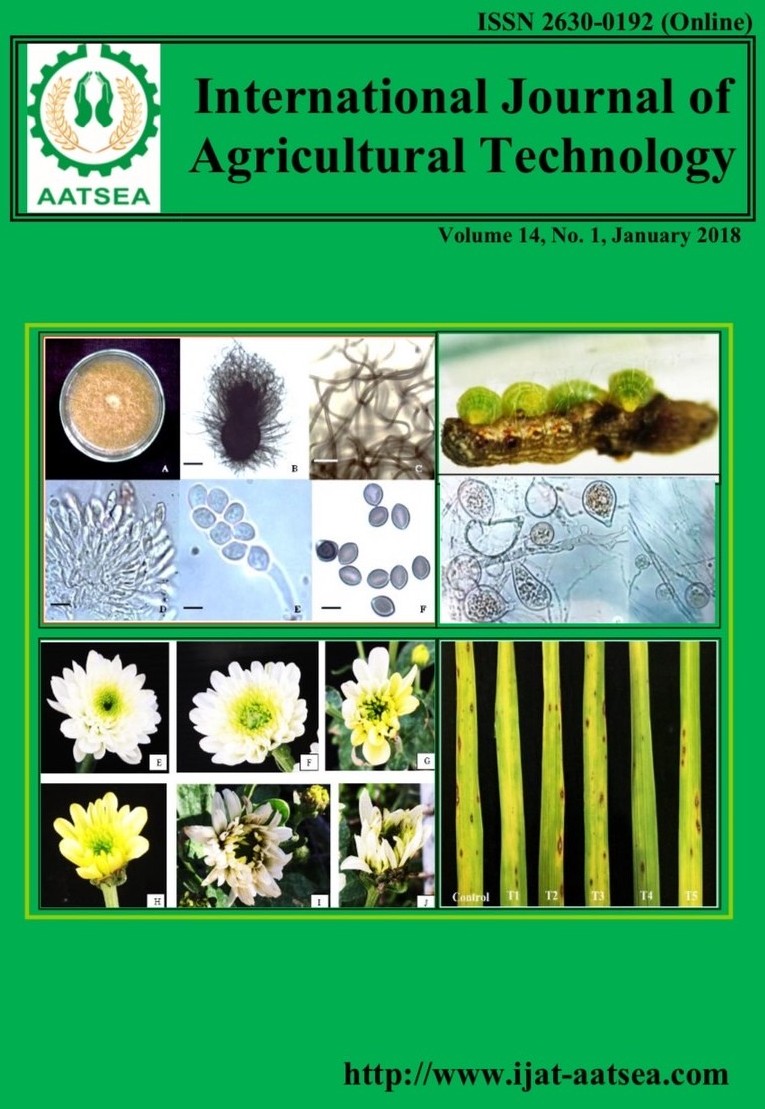Effectiveness of Bottle Brush (Callistemon lanceolatus DC.) Leaf Extracts to Control the Nymph of Mealybug (Phenacoccus manihoti Matile-Ferrero)
Main Article Content
Abstract
Mealybug (Phenacoccus manihoti Matile-Ferrero) poses a threat to cassava-growing regions of the world. A current global interest has focused on the discovery of non-chemical strategies and environmental friendly pest control approaches. The objective of this study was to investigate the efficacy in terms of toxicity and repellent properties of hexane, acetone and ethanol crude extracts from leaf of bottle brush (Callistemon lanceolatus DC.) against the nymph of mealybug (P. manihoti) by using leaf dipping method. Various concentrations of bottle brush extract, 0 (5% tween-20 water) 1, 2, 3, 4 and 5% (w/v) were applied. Then the insect mortality was observed at 24 and 48 hrs whereas, the repellent index (%RI) was observed at 24 hrs. The results showed that acetone extract from bottle brush was highly effective in killing the nymph of mealybug with the LC50 at 24 and 48 hrs as 3.54 and 2.28 %, respectively. Acetone and ethanol extracts of bottle brush at 2-5% concentrations showed very strong effect in repellence when the nymph of mealybug with >75% RI was found within 24 hrs. Therefore, the acetone extract of bottle brush leaf was highly containing insecticidal activity against nymph of mealybug in laboratory, then the next filed condition substance should be developed.
Article Details

This work is licensed under a Creative Commons Attribution-NonCommercial-NoDerivatives 4.0 International License.
References
Abbott, W. S. (1987). A method of computing the effectiveness of an insecticide. Journal of the American Mosquito Control Association 3:302-303.
Bellotti. A. C., Smith, L. and Lapointe, S. L. (1999). Recent advances in cassava pest management. Annual Review of Entomology 44:343-370.
Daane, K. M., Bentley, W. J., Walton, V. M., Malakar-Kuenen, R., Millar, J. G. and Ingels, C. A. (2006). New controls investigated for vine mealybug. California Agriculture 60:31-38.
Danga, S. P. Y., Nukenine, E. T., Younoussa, L., Adler, C. and Esimome, C. O. (2015). Efficacy of Plectranthus glandulosus (Lamiaceae) and Callistemon rigidus (Mytaceae) leaf extract fractions to Callosobruchus maculatus (Coleoptera: Bruchidae). Journal of Insect Science 15:139.
Goyal, P K., Jain, R., Jain, S. and Sharma, A. (2012). A review on biological and phytochemical investigation of plant genus Callistimon. Asian Pacific Journal of Tropical Biomedicine 2:1906-1909.
Hoffmann, H. (2011). Aphids, mealybugs and scales; common sapsuckers in the home garden. Department of Agriculture and Food of Western Australia. 499 pp.
Isman, M. B. (2000). Plant essential oils for pest and disease management. Crop Protection 19: 603-608.
Kumar, S., Kumar, V. and Prakash, O. M. (2011). Antihyperglycemic, antihyperlipidemic potential and histopathological analysis of ethyl acetate fraction of Callistemon lanceolatus leaves extract on alloxan induced diabetic rats. Journal of Experimental and Integrative Medicine 1:185-190.
Lo, P. L. and Walker, J. T. S. (2010). Good results from a soil-applied insecticide against mealybugs. New Zealand Winegrower 14:125-127.
Mibey, R. K. (1997). Sooty moulds. In: Ben-Dov, Y. and C.J. Hodgson, eds. Soft Scale Insects: Their Biology, Natural Enemies and Control, Amsterdam and New York: Elsevier. pp. 275–290.
Miller, D. R., Miller, G. L., Hodges, G. S. and Davidson, J. A (2005). Introduced scale insects (Hemiptera: Coccoidea) of the United States and their impact on U.S. agriculture. Proceedings of the Entomological Society of Washington 107:123-158.
Papachristos, D. P. and Stamopoulos, D. C. (2002). Repellent, toxic and reproduction inhibitory effects of essential oil vapours on Acanthosecelides obtectus (Say). Journal of Stored Product Research 38:117-128.
Park, B. S., Choi, W. S., Kim, J. H., Kim, K. H. and Lee, S. E. (2005). Monoterpenes from thyme (Thymus vulgaris) as potential mosquito repellents. Journal of the American Mosquito Control Association 21:80-83.
Pascual-Villalobos, M. J. and Robledo, A. (1998). Screening for anti-insect activity in Mediterranean plants. Industrial Crops and Products 8:183-194
Singh, S. and Shiva, S. (2014). Genus Callistemon: an update review. World Journal of Pharmacy and Pharmacetical Sciences 3:291-307.
Soliman, M. M. M., Hassanein, A. A and Abou-Yousef, H. (2005). Efficiency of various wild plant extracts against the cotton aphid Aphis gossypii Glov. Aphdidae: Homoptera). Acta Phytopathologica et Entomologica Hungarica 40:185-196.
Wakgari, W. M. and Giliomee, J. H. (2003). Natural enemies of three mealybug species (Hemiptera: Pseudococcidae) found on citrus and effects of some insecticides on the mealybug parasitoid Coccidoxenoides peregrines (Hymenoptera: Encytridae) in South Africa. Bulletin of Entomological Research 93:243-254.
Yi, D., Cui, L., Liv, Y., Zhauang, M., Zhauang. Y., Fang, Z. and Yang, L. (2011). Transformation of cabbage (Brassica oleracea L. var. capitata) with Bt cry1Ba3 gene for control of diamondback moth. Agricultural Sciences in China 10:1693-1700.


